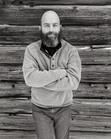Classical Photographers and Jazz Photographers
I’ll play it and tell you what it is later. —Miles Davis
This is a re-edited version of an article originally published in the online magazine On Landscape. If you are not already a subscriber, I recommend it highly. (Note, this is an unsolicited, unpaid personal recommendation, not an advertisement.)
~~~
Ansel Adams spent much of his early years training to become a classical pianist. He often mused about the ways his musical training has influenced his photography. In one interview, Adams said, “Study in music gave me a fine basis for the discipline of photography. I’d have been a real Sloppy Joe if I hadn’t had that.” He also famously claimed, “The negative is the equivalent of the composer’s score, and the print the performance.”
Adams’s references to discipline and his analogy of performing a composer’s score likely are relatable to anyone familiar with the rigors of practicing and performing classical music. But such references may not apply in quite the same way to jazz musicians who, while still practicing relentlessly to achieve technical excellence, improvise in real time when performing rather than adhere precisely to a composer’s score.
The difference between classical and jazz musicians occurred to me some years ago when preparing a set of prints for an exhibition. Although I had printed the same images numerous times before, I found myself re-editing every one of them, some in quite different ways from my original visualizations. My original exposures—film and RAW files—did not point me to any singular “right” interpretation in the same way that a composer’s score might direct a classical performer. Instead, these exposures and the memories of their making set for me a general mood—a visual rhythm, a baseline to improvise around, in some cases to depart from in a quite undisciplined, spontaneous, and enjoyable ways.
Although I recalled my original intents and visualizations quite vividly, I also experienced new epiphanies, enjoyed experimenting with new interpretations, applied new tools and techniques I did not possess when making my initial edits, and in some cases ended up “performing” quite different “visual music” than I originally conceived. I realized then that performing a score was not a good analogy to describe my way of working. Instead, I felt more like I was jamming, riffing, improvising, experimenting in much the same way that a jazz musician may explore new possibilities while playing.
In both classical and jazz music, the act of playing may amount to executing a practiced routine by rote, or it may be an opportunity for a creative player to express their own interpretation of the music. Skilled classical and jazz musicians alike may enrich a composer’s original notes, adapt their performance to imbue the original score with their own feelings and style. Performing both forms of music also may yield the effect of flow, ensuing from intense attention-consuming concentration while performing.
The main difference, as far as the performer is concerned, is the degree of freedom that players allow themselves to depart from the score and from their practiced routines. Classical musicians aspire to perform the music on stage exactly as they rehearsed it. For jazz musicians, however, the rehearsed music is just a starting point they may choose to freely depart from at any time. When performing, jazz musicians do not feel beholden to any prior interpretation—not even their own—and may adapt their playing in real time into something different from any other performance of the same piece.
Thinking about the distinction in a broader sense, I believe that some photographers, like classical musicians, seek to elevate the emotional impact of their visual performances by way of technical excellence and by use of beautiful light, colors, and tonal transitions, but generally stick to “performing” their visualized—preconceived—compositions (whether these compositions are their own or copied from others). Other photographers, like jazz musicians, vary their compositions and performances in real time, aiming to express their own emotions as they arise by whatever means are available to them, in general disregard to their original visualizations or to how others may have photographed the same subjects.
“Classical photographer” may plan and practice intensely, aiming for a perfect performance of a preconceived score. “Jazz photographers” use their original “score” as a baseline but strive to make choices in real time, adapt quickly to unexpected conditions, new moods, emergent feelings, and serendipitous epiphanies. They may change their minds at any time, even when re-processing or re-printing images they previously considered as “finished.”
Recent studies have validated Adams’s claim about the general benefits of musical training in improving discipline and accuracy. Brain imaging studies show that musicians’ brains have conspicuously greater connectivity between the left and right hemispheres compared with the brains of non-musicians. Similar studies also show that brains of classical musicians adapt in different ways than brains of jazz musicians.
A 2018 study done at the Max Planck Institute showed differences between classical and jazz pianists in the way they prepare themselves to play consecutive notes. According to the study, musicians constantly consider and predict how they will play upcoming notes to ensure proper technique and harmonious progression. This mental preparation involves considering what note to play next (i.e., what keys on the piano they will need to press), and how they will play this note (i.e., the fingering technique needed to press the keys correctly). The study showed that classical musicians focus more on the “how”—on technique—while jazz musicians, in contrast, focus more on the “what”—on deciding what the next note will be in real time, ensuring it will fit harmoniously with the previous notes, even if departing from them (and from the original score, if there is one) unexpectedly.
In classical music, emotional meaning comes largely from the composer. In jazz, meaning comes from the performer, who is free to express different meanings in different performances, even if ostensibly playing the same title.
When it comes to the separation of roles between composer and performer, photography as a medium lags considerably behind music. Most photographers and viewers of photography make no distinction between composer and performer, assuming implicitly that they are always the same person, despite this often not being the case. In landscape photography, especially, the case is almost always the opposite: few original composers make meaningful, novel creations, which are then “performed” repeatedly by many others (who usually have no qualms about claiming the entire production—composition, performance, and all, as their own).
The failure to separate composers from performers in photography has led some to question the artistic merit the medium, and especially of such styles as “straight photography.” For example, in 1907, pictorialist photographer Robert Demachy posed this thought experiment:
Choose the man whom you consider the very first landscape artist photographer in the world; suppose he has, thanks to his artistic nature and visual training, chosen the hour and spot, of all others. Imagine him shadowed by some atrocious photographic bounder furnished with the same plates and lens as the master. Imagine this plagiarist setting his tripod in the actual dents left by the artist’s machine and taking the same picture with the same exposure. Now, suppose that both are straight printers? Who will be able later on to tell which is the artist’s and which is the other one’s picture?
The moral of this fable is twofold. It shows that a beautiful straight print may be made by a man incapable of producing a work of art, and that a straight print can not possibly be a work of art even when its author is an artist, since it may be identical to that taken by a man who is no artist.
I agree generally with Demachy’s sentiment. Rampant and commonly accepted plagiarism is a formidable hurdle for photographic artists wishing to be recognized for their original, creative efforts. Still, if we consider Demachy’s scenario with a clear separation between the roles of composer and performer, I think it is fair to say that the person who composed the original photograph is very much deserving of praise and artistic recognition. Bach, for example, is no less an artist just because countless performers have played his original scores in ways that may be difficult to distinguish among.
I know myself to be a “jazz photographer”—a real-time improviser, not a disciplined performer of preconceived/visualized “scores.” When I set to make a print for myself or for an exhibition (i.e., not a print purchased by a customer expecting it to match the appearance of a digital version or of a previous “performance”), I consider it as an opportunity to make a new creation—new “visual music”—not necessarily aiming to re-perform my original visualization by some singular, fixed, “right” interpretation. Each “performance” is for me a chance to make something new and original.
“An original work, an aha! product or a fresh insight”, wrote journalist Timothy Egan in a 2014 New York Times piece about creativity, “is rarely the result of precise calculation at one end producing genius at the other. You need messiness and magic, serendipity and insanity.” To me, this description suggests quite a different endeavor—and attitude—than, as Adams put it, “performing a composer’s score.”
~~~
If you’ve enjoyed this article, please consider making a small contribution to support this blog. Thank you!




